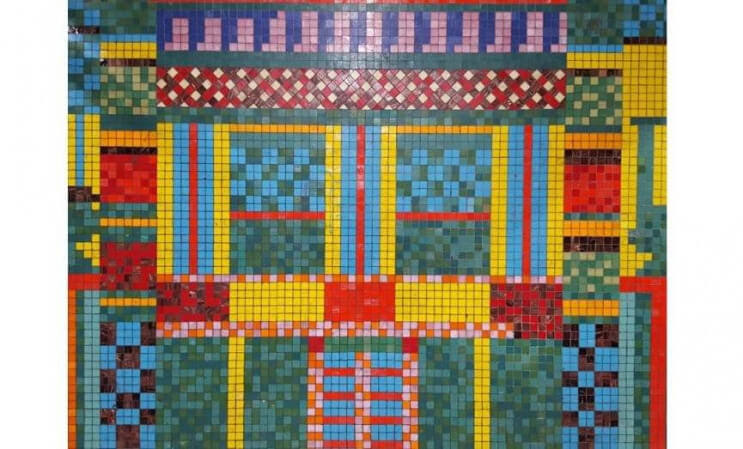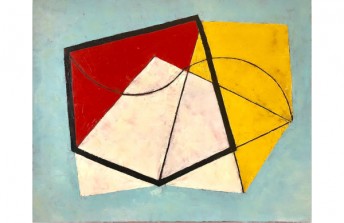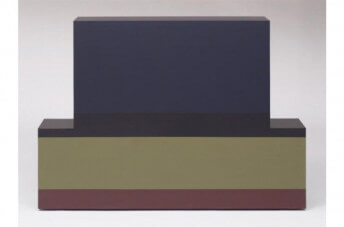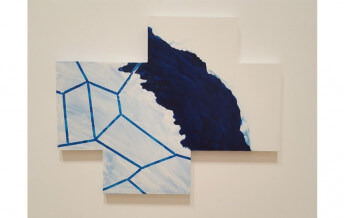Saving Tottenham Court Road Mosaics by Eduardo Paolozzi
Jul 11, 2016
Many people may not associate public transportation with art. But London’s Tottenham Court Road Tube Station may be the most visited art destination in Britain. The station, which accommodates many of the Tube’s total 36 Million+ annual riders, is home to roughly 1000 square meters of mosaic murals by Eduardo Paolozzi. Knighted by Queen Elizabeth II in 1989, Paolozzi was also named a Commander of the Most Excellent Order of the British Empire (CBE) and was elected to the Royal Academy of Arts. He founded the Independent Group, an artist collective considered to be the conceptual precursors to the British and American Pop Art movements. And Paolozzi’s 1947 collage I was a Rich Man's Plaything is considered to be the first work of Pop Art ever made. Paolozzi’s Tottenham Court Road Tube Station murals have recently been the focus of an intense public debate as renovations at the station have necessitated several of the murals be removed or relocated. The IdeelArt team recently visited the station in an effort to preserve pieces of these important works in photographs.
Progress Strikes Again
It’s frustrating to see important works of Modernist art taken out of the public sphere. But this actually isn’t the first time the work of a British artist has been removed from Tottenham Court Road Tube Station. This rail station originally featured what has come to be recognized as the iconic green and white tessellated geometric tile work common in many of London’s tube stops. The British architect Leslie William Green designed that tile work. Green died in 1908 at age 33 after suffering health problems reportedly caused by the stress of designing more than 50 rail stations in just five years.
Despite the artist having died for his efforts, Tottenham Court Road Station’s original tile art was destroyed without fanfare in the 1980s when a major redesign of the station included the introduction of Eduardo Paolozzi’s mosaic murals. Though many art lovers see the replacement of Paolozzi’s murals as a disgrace, the cycle of opportunity for contemporary artists continues, as it did for Paolozzi during his time. The renovations causing Paolozzi’s work to be removed have resulted in the addition of several large-scale geometric abstract works by the French conceptual artist Daniel Buren. And future plans for the station include the addition of work from artists such as Scottish Turner Prize winner Douglas Gordon and London-born artist and musician Richard Wright.
Celebrating the Original Concept by Eduardo Paolozzi
When Paolozzi originally designed his murals for the Tottenham Court Road Tube Station, his primary objective was to capture the identity of the location itself. Since the neighborhood was home to a large number of electronics stores, for example, he included a number of musical references in his murals. He also developed an aesthetic that spoke to the dawning of the digital age, using small squares that evoke the electronic/digital, 8-bit aesthetic of video games, an aesthetic that has once again rose to mass cultural prominence today.
Paolozzi’s secondary goal with his Tottenham Court Road Tube Station murals was to continue to express his own personal artistic voice. That voice was focused on mixing mass culture with high culture to create a new Modernist point of view. In the 1950s when he founded the Independent Group (IG), Paolozzi was fascinated with collage and with working with found objects. At the first meeting of IG, he established the look he believed should be at the vanguard of his new Modernism by projecting on the wall a series of clippings from popular magazines, which included advertisements, comics and graphic designs. Together these clippings presented an aesthetic that became central to the formation of Pop Art.
Saving Paolozzi’s Murals
Paolozzi’s mixture of mass culture and high culture was most poignantly expressed in his Tottenham Court Road Tube Station murals. They connect mass transit and the forces of modern commerce with accessible works of art. His success in bridging the various elements of modern culture is obvious. Dozens of news agencies brought attention to the murals’ fate, and thousands signed a petition to save Paolozzi’s work from destruction. Those efforts paid off. Some of the murals are now going to be relocated elsewhere in the station, and others, including the arches once located above the escalators, are being added to the permanent art collection of Edinburgh University.
Edinburgh University already possesses around 150 of Paolozzi’s works. The murals the university will be acquiring from the tube station will be carefully restored over a period of several years at the Edinburgh College of Art, with the help of art students there. Paolozzi himself once studied art there and also eventually returned to the campus as a visiting professor. So thanks to the efforts of the public, the Paolozzi murals removed from the Tottenham Court Road Tube Station will find an appropriate home, and those that remain will be cleaned and restored.
Lost and Found
Despite the anxiety this debacle caused many art lovers, something central to Paolozzi’s work makes him the ideal representative of issues regarding the preservation of public art. Paolozzi believed that mass culture and high culture could mix naturally. His aesthetic, which so often included found objects and collage, was designed to be widely relatable and easily accessible to most viewers. He didn’t intend for his work to be held in such high regard that it could never be replaced. In fact, he devoted much of his life to the idea that Modernism was in constant need of refreshing.
We’re proud that fans of Paolozzi’s art stood up and were counted, and also that a way forward has been negotiated in which Paolozzi’s murals are being celebrated through a mixture of documentation, preservation and relocation. And we’re also thrilled to be given the chance to see the public art contributions of this generation’s contemporary voices of Modernism. As we believe Paolozzi himself would, we advocate for a society that is both appreciative of the gifts of past generations of artists, and also firmly embraces the aesthetic needs of the our time.
Featured Image: Eduardo Paolozzi - Tottenham Court Road Mosaics






